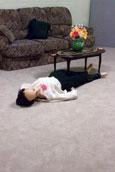Storage rooms become crime scenes

A mannequin lies ready for students to process the simulated crime scene. Fake blood on the wall and hidden evidence are among the clues to consider.
When students walk by room 43 in the Anderson Criminal Justice building, looks can be deceiving – it’s not just a storage room.
Rooms 43A, B and C are designated as rooms for real-life situation training for Missouri Southern students pursuing law enforcement related careers.
“These rooms are just so great to have,” said Greg Dagnan, assistant professor of criminal justice administration. “I can’t tell you how hard it was to set something like this up in a classroom, it just was not realistic at all.”
Dagnan said Tim Dodge and his crew at the Physical Plant successfully created the best learning environment possible. A year ago, students and faculty donated random, home-related objects to help complete the facility. Students who have participated in these training rooms agree the atmosphere is better than the average classroom.
“It was really interesting,” said Sheldon Kennedy, freshman computer forensics major. “It’s not everyday to see a mannequin laying on the ground, dressed up like it was a real crime scene.”
In learning the procedures of search and investigation, Dagnan says the rooms help students imagine the situations and how they would react under certain circumstances.
“There’s a couple of scenarios used that are based on real cases,” he said. “There’s going to be some pretty minute evidence in here for [the students] to preserve and find.”
Besides methods from the book, students can also reap the benefits of experience on a crime scene.
“I vacuum the carpets before every technical, so that we can leave footprints,” Dagnan said. “This is neat to see if [the students] actually stop and look, or if they just walk right in.”
Dagnan and his students are not the only ones benefiting from these facilities. Other related classes, such as crime report writing and photography, find the rooms efficient in training students in what to look for. Another example is the forensic students training to run and operate ambulances. This interchanging of uses for the rooms spawned another idea for the faculty.
“Mike Krtek [instructor of paramedic training] is going to come into my class for the first time and talk about why paramedics do the things they do, because crime scene investigators get really frustrated with the paramedics for messing up the crime scene,” Dagnan said. “I’m going to go into his class and talk about preserving a crime scene, so we’re going to switch a little bit, so I think that’ll be pretty neat.”
Kennedy says he can appreciate this concept of intertwining relationships in crime scene investigations.
“They want us to be aware of everything going on in a crime scene,” he said.
This program is not through advancing. Dagnan said the department is trying to push through another proposal to turn one side of the storage room, room 43, into a convenient store setting for further law enforcement training.
“If you look at the most common crime scene people are going to encounter, of course the house is going to be the first, but we’re thinking the convenience store will be a very common crime scene as well,” Dagnan said.
If the department receives the funding, the convenience store setting will be another asset to the criminal justice training program. Some students already in the program said they are taking advantage of this opportunity.
“I figured this would be beneficial to my work in the future,” said Catherine Ramoly, freshman criminal justice administration major.
Currently, the only downsides in the program are the classes are always full, which Dagnan said will always be a problem, and one other problem he has run into with his students, which indicates more room for improvement.
“By the time we get down to the final, the students are already familiar with these rooms, so it’s not like they’re going in cold, whereas it would be nice to have another area that they’ve never seen before,” he said.
Your donation will support the student journalists of Missouri Southern State University. Your contribution will allow us to purchase equipment and cover our annual website hosting costs.



























